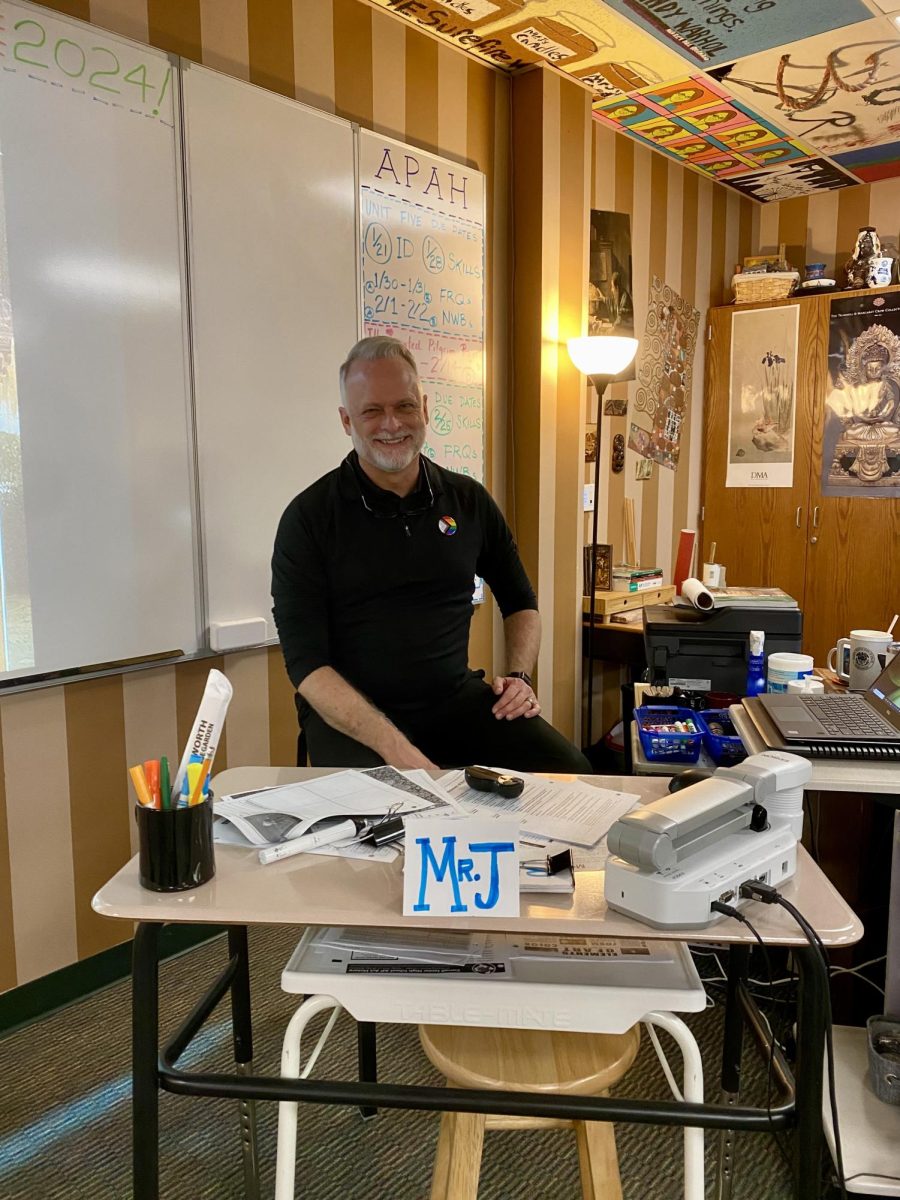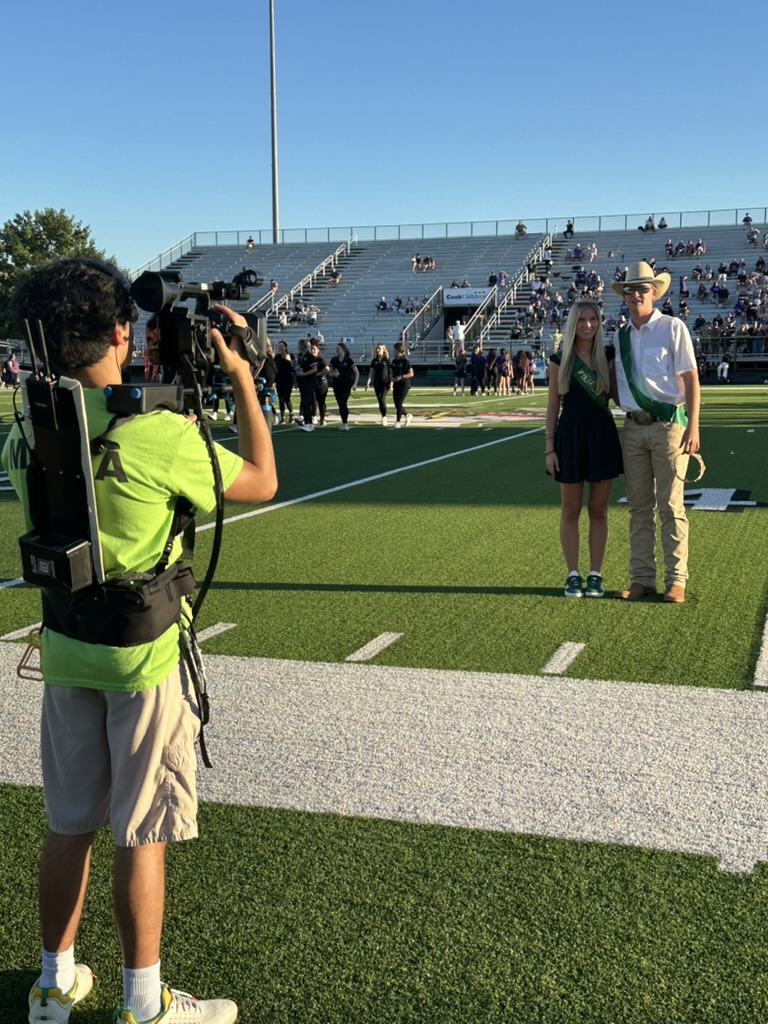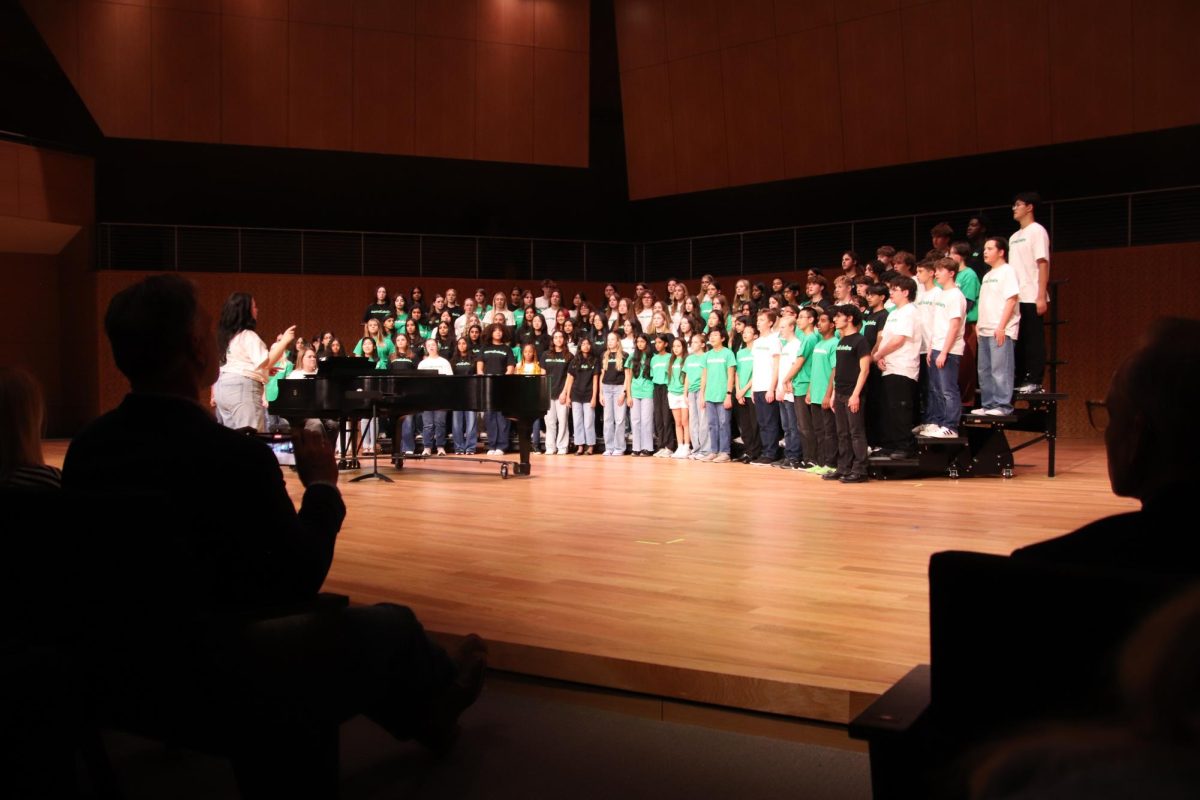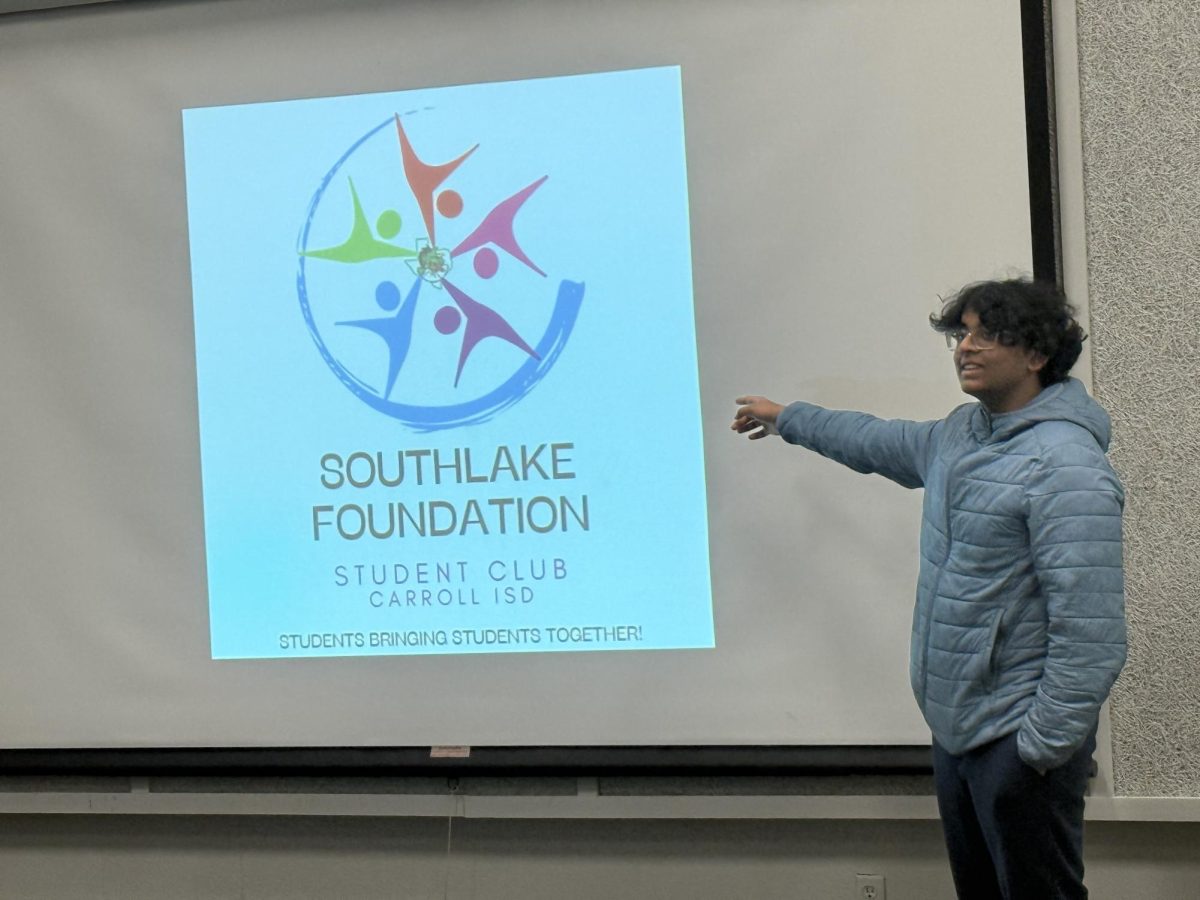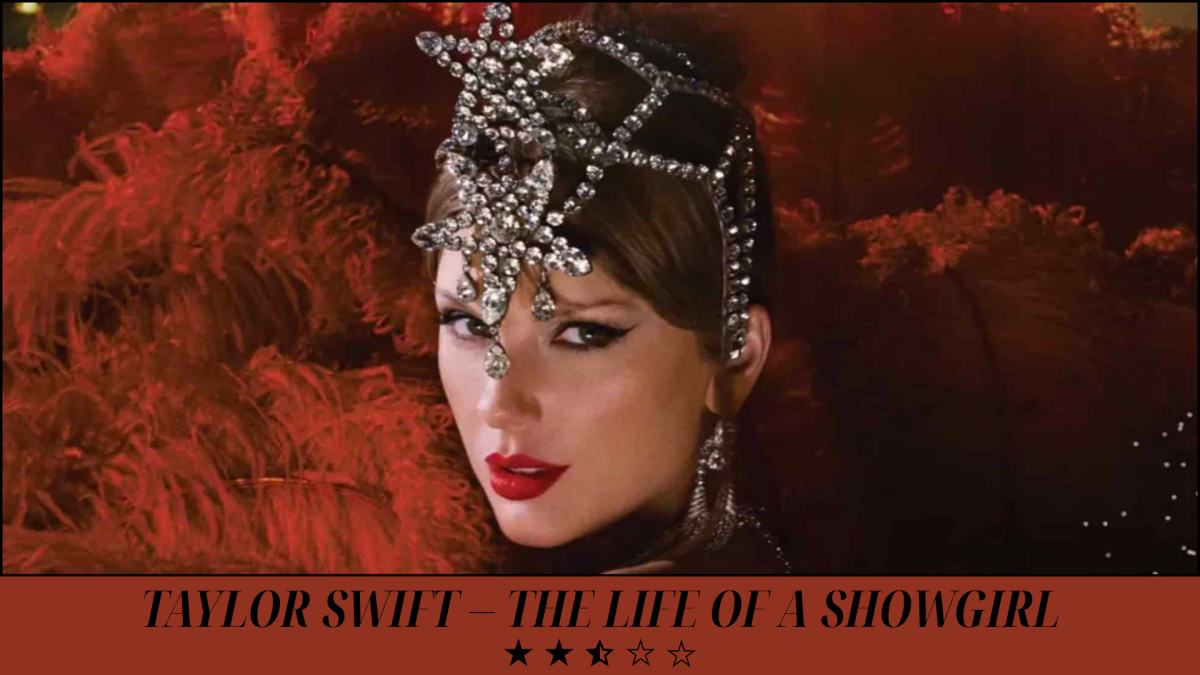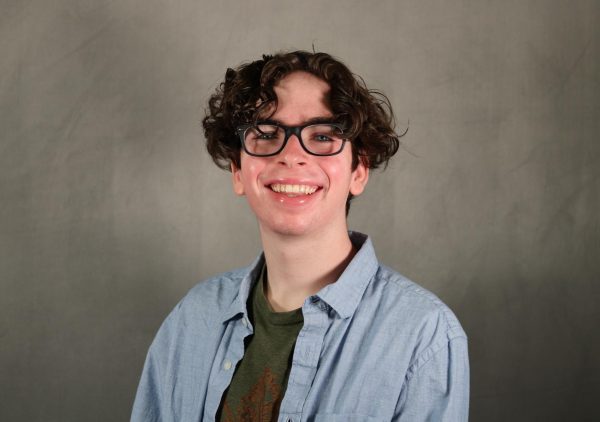Q: First off, we have to talk about this room. There’s so many different components. How have they come together over the years?
A: We’ve seen so many different iterations. When I started working here, there was a teacher who was in this classroom, she had the ceiling tiles wrapped in paper, and students painted on top of the paper. So eventually, they could take their artwork with them, but usually, they just left it behind. We had a fire code inspection one year, and we came back in the walls and more white, all the artwork had been taken off, because we can’t technically have anything on top of the tile; they’re a protective fire barrier. So somebody said, “Can we just paint on them?” Dr. Presley was our principal at the time, so I went down and asked him. He said, “Yeah, I have no problem with that.” So it kind of started 2003-2004.
We did a little bit each year, students were asked to take a tile home, and they had to choose an art history related theme or artwork, or something they thought was funny in class, and build kind of a meme tile out of it. So some of these have been here since the beginning, some have been painted over where kids came in, like, “I’m tired of this one, and I think I can do better.” But that was always the challenge, you have to do better than what was on it before. Your artwork has to have staying power. If you want to come back next year and see it, some kid may have chosen that one to paint over. So it’s just been kind of going, I think we got built out right about 2018. I mean, we have every tile in the room covered. So it’s just kind of a neat way to catalog the different classes and see what things were funny at different times in history. A lot of them I’ll still use for instruction, like that one that “Got milk?” We’ll talk about that the day that we get to abstraction. Nobody knows what that is.
No, I don’t.
After that lecture, you will. They’re just pretty fun. They’re still fun for instruction as we go. I don’t want to be the person who has to take them down, you know, after I retire, holy cow.
Q: Yikes, yeah. Do they have to re-paint over them or get all new ones?
A: I think that they just can come in and trash them and then re-cut new tile or I don’t know, a friend of mine who did this in another district, she actually came in and sneaked some tiles home. I’m like, I have nowhere to store! There’s so many of them. I’ll take a picture of them before I leave, each one. But yeah, end of era, I guess. Maybe the next person will pick up where we left off.
Q: What’s been your journey to teaching?
A: This has been kind of interesting. You know, I came to Carroll not initially to teach art history. I was hired way back in ‘98 as a color guard instructor who could also teach. I was in the classroom doing economics, six blocks of on-level economics the whole time, did that for a couple of years, then picked up AP Euro.
And based on that experience, the lady who hired me here, who was the head of the social studies department, was getting ready to retire. They were doing humanities at the time, which was Art History and British Lit kind of taught side by side together. So when she left I took her Art History place in that program. Out of that it generally just grew into separate AP English and AP Art History. So that’s basically how I’ve ended up with this teaching assignment coming here, not really to do it, but then falling in love with it after I did it for a couple of years. I guess I got lucky. She saw in my college career that here’s a kid who did theater, who took Latin, who did a couple of art classes. And I guess she saw that maybe that checks all the boxes for what she wanted to do later.
Q: Obviously, art history is the passion here, but you also teach on-level economics. How does teaching those two totally different subjects work for you?
A: It’s you know, I tell people that that’s my teaching assignment and they get the same kind of quirky like, “Oh my God, how do you do that?” I kind of enjoy it actually, because it works different spheres of my brain a little bit, you have to teach those content areas pretty differently. With Economics, it’s something that I’ve watched change over time, as we’ve gone through recessions and periods of expansion, all those principles kind of stay the same. It’s interesting to see how the different parts of it feel when you go through the business cycles. So it’s also been reassuring knowing that it’s a cycle, when we get into these really typical times that you know, what goes down must come up. It’s been fun to follow economics for the duration, but, of course, my passion is Art History. That’s probably what I’m going to study after I retire, pretty much, as a graduate degree. But there’s so much, it’s vast and expansive. And so I’m looking forward to kind of digging in a little bit more with that, too.
Q: Yeah, what are your plans for this next year? I know you have some big ones coming up.
A: Well, I had been thinking about retirement for a couple of years now and only recently became eligible to do so. That was in October: my birthday was in October. So I had the option to leave at the break in December. And I’m like, “I need to finish the cycle. I’m not quite done yet.” So basically, that was when I decided I would finish the year. When I planned to retire, we were gonna move over eventually to where our grandkids are. But the housing market is not cooperating with us right now, so we’ll wait and just hang out in North Texas and in the meantime, I’ve applied to go to graduate school at UTD in the Art History program there. So I’m super excited.
Q: Did you study art history when you were in undergrad?
A: A little bit, but I didn’t really see it as an option for full on study, because I didn’t see myself at that time as being like a high school teacher or teaching that. I knew it wasn’t really offered everywhere. So it wasn’t a popular choice, even though I liked it at that point. I thought I’d better probably go the route of US History, or World History, or Economics, or something like that. And so that’s initially where I went first, but had no idea that I would find Carroll and find a program and then start exploring it more more intently then. So I’m looking forward to what comes next for sure. I didn’t want to just go home and crochet even though, if that’s what you want to do, that’s fine. I wanted to go on and do more with it.
Q: What’s been your favorite part about teaching, any class really?
A: Well, you go in with an agenda. You know what you need to get done. 1, 2, 3, 4, 5. But then you remember, “Oh, the kids have a different agenda.” And so the main part of it can be challenging getting to know the different personalities that walk in the door, but it’s those personalities and interactions that make every year unique and distinct, and different and fun. And, you know, it’s always a risk starting the year, because you don’t know the mixed bag you’re gonna get, but by the end of it, you feel really like family, and like colleagues working toward the same thing. It’s a lot of fun. That would have to be it.
Q: What’s your favorite piece?
A: Ah, the favorite piece question. So difficult to explain why for art historians. Naturally, when I started studying, I was like, “Oh old world, ancient civilization.” That’s where I spent most of my time. But since that time, I’ve kind of learned more about art, and I’m really finding I have a passion for early modern 20th century: Matisse, Picasso and all the other host of artists who are trying to break away from the mold of what an academy was saying that they really shouldn’t be doing. I’m reading biographies on Matisse and Picasso right now, and it’s just amazing the struggles that they just personally had to go through to convince themselves they were even close to something that was really avant-garde. That’s an area that I didn’t study in my undergrad, I’m gonna kind of try and focus on that as I move forward with a graduate degree, possibly. I still want to do a broad-based approach so that I don’t study one artist so deeply, that’s all I know. But art is global, and there’s a lot of traditions out there, so I’ll work to try and balance it. But that will probably be a focus not gonna lie, because it’s just incredible to see what they come up with. There’s a lot about the early 20th century that reminds me of what we’re going through right now. There’s just an era of change and an era of really crazy ideas. And no one had tried any of this before. And so these responses seem oddly familiar, visually.
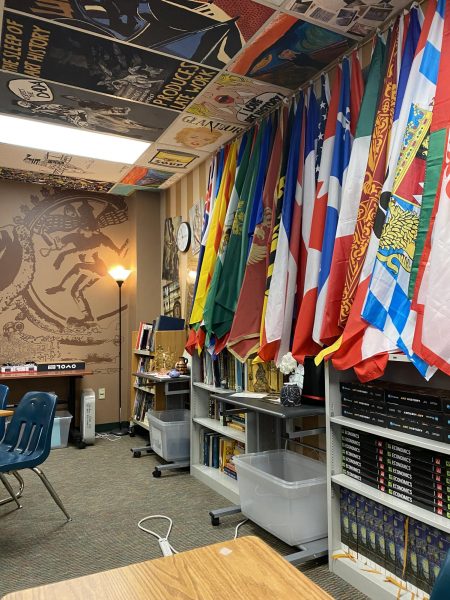
Q: So with the flag corner, can you explain that kind of journey?
A: Absolutely. The flags basically come from my travels with kids initially to places over spring break, we’ve been to places like Italy, where we went to Rome and Florence, and we’ve gone to Spain, Madrid, Barcelona, London, Paris, Berlin, Prague, Vienna, those kinds of places. So I just started collecting flags, partly because they were portable and easier to carry than posters. But then just kind of as a record of where we had been. And then I got into city flags and flags like from the Vatican. So they’re up there too. And kids come in and go, “Wait a minute, what country is that” But it is really a record of where I’ve traveled even since then, on personal trips too. I put the US flag and the Texas flag there just as a reminder that, you know, they’re one among many, it’s not the only end all be all nation that there is. It’s really a family of nations that we’re all kind of part of, and it’s up to us to kind of make that work. I hope that helps do that a little bit by reminding people, “Hey there’s a lot out there.”
Q: Another journey you’ve talked about is seeing as many of the artworks as you can from the course.
A: I have a friend who’s in HEB, and she’s actually doing a better job of that than I am: she’s got a higher number. But it was always interesting to me to see the artworks in a way where you could walk around them, and see angles and things that never show up in the textbooks. When it comes to seeing architecture firsthand, I think that is absolutely the best way to walk through a space. Because it’s so hard to teach, conceptually, what that’s like to someone who’s never been there. So travel dovetails really nicely with instruction that I’m trying to pull off in class. So I’m always a proponent of travel and go see for yourself, because that’s the best teacher.
Q: After grad school, do you plan to keep going on that?
A: Yeah? I mean, I’m retiring fairly early, although 53 sounds kind of old. So I still think I have a little bit of wind in me left to see more. I have yet to make it to Asia, I want to do Japan. I really want to see as much as I can of China, though that might be challenging in the current political climate. But there’s just a big world there that I haven’t even tapped into, so I already have trips planned to Australia and New Zealand. This summer I’m going to be traveling to Europe, again, but to places in Europe that I’ve not seen before in Belgium, Luxembourg, and Amsterdam. So I think that will probably continue. Probably my training and my travel will butt heads I’m pretty sure at some point. We’ll see.
Yeah, New Zealand is absolutely a bucket list place for me.
I had a friend who went there, and she was showing me everything that she saw on the South Island. I’ve been to the North Island twice before because my dad worked in New Plymouth on the west side of the North Island. But it was very localized to that. I didn’t really know what to look for at that point. So this will be a nice way to see everything, which is pretty cool.

Q: If you could have a conversation with any artist living or dead. Who would it be? I’m guessing Picasso or Matisse?
A: Well, I guess right now Picasso and Matisse. Yeah. Man, the biography that I’m reading on Matisse right now by Hilary Spurling, it’s in two volumes, and it’s thick. I’ve already gone through the first one, just like before bed each night. I’m reading, reading, I fall asleep and I’m like, I’ve already done that, it’s amazing. But he strikes me as someone that really was kind of the grandfather of the avant-garde, though he would never tell you that. Apparently, from his biography, he second-guessed himself so many times. He had really miserable periods where things just were not clicking for him. It was the people around him that supported him and prodded him on. I mean, that seems very human to me, to doubt yourself and not be sure that you’re moving in the right direction. I mean, Picasso and he were rivals. And Picasso goes in a very different direction than he does and when he sees that he’s like, “Am I doing it right? Is he right? Am I wrong?” That just seems like a very human emotion to me. I’d like to probe and see you know, “How did you cope with that? How did you…?” I guess I have to read the second book. So that’s in my future for sure.
That’s actually very reassuring to hear honestly. Because he seems so sure of himself, and he’s done all this stuff.
When they show up in a textbook, there’s just this assumption that they are the model, this is who we should know, and then why. But we forget that they were very human people. You know, one of many who might have succeeded that well. So it’s pretty cool.
Q: Is there anything else you want people to hear?
A: Sure. I’ve got grandkids. We just came from Walt Disney World last summer. I’m pretty proud of them, and excited to hopefully at some point, you know, share a little bit of the art world with them, and then see their interests grow. My husband and I will be celebrating our 35th anniversary this year. He’s just newly retired, and I will be retired. So we’re looking forward to celebrating our time together in the future. It’s been a real special place to be out and gay and comfortable with who you are. And that speaks well of the community that we’re in. I hope to see more of that supported in the future, in the school district. So I would definitely want people to know, I’m proud of that, and I think other people should be too.
